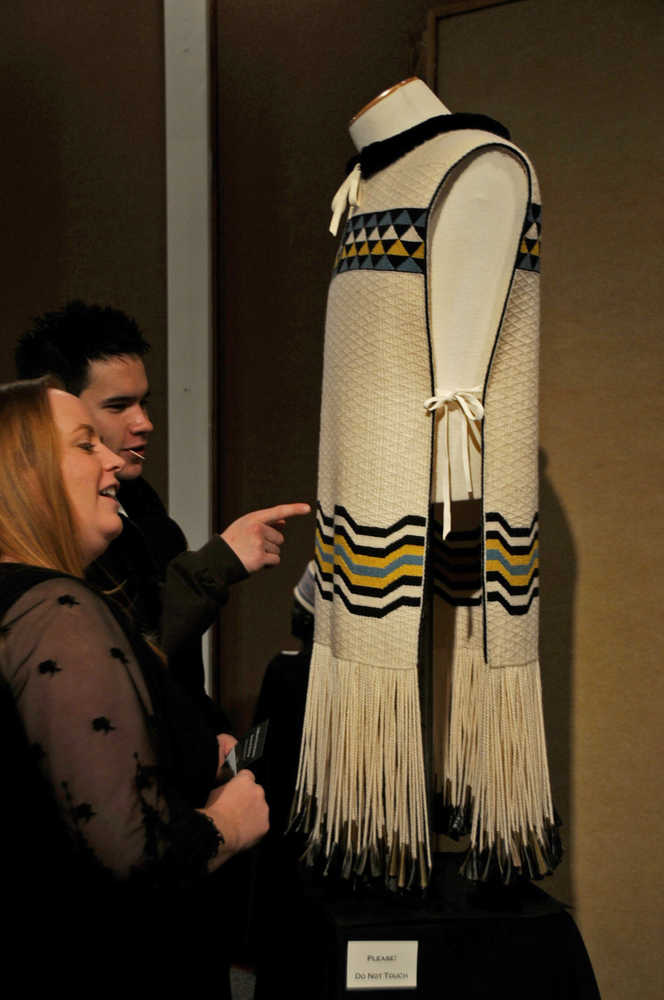At first glance, the Ravenstail robes don’t look like a piece of lost history.
Had it not been for a group of enterprising weavers in Juneau, they might have been. Ravenstail-style weaving all but disappeared from the Pacific coast of Alaska and Canada about 200 yearsago, replaced by Chilkat weaving. A collection of robes, hats, tunics and other pieces on display this spring at the Kenai Visitors and Cultural Center is a sight that few people have seen since the early 19th century.
Kay Field Parker, a Juneau artist who wove all the pieces on display at the Kenai Visitors and Cultural Center, is one of a growing group of artists worldwide who practice the ancient style of weaving.
Although the pieces seem to have been highly valued among the various cultures of Alaska Natives and First Nations of Canada, it disappeared without much of a trace — only 15 examples remain, Parker said. Parker said although the pieces seem to have been highly valued among the various cultures of Alaska Natives and First Nations of Canada, Ravenstail weaving disappeared without much of a trace. Only 15 examples remain.
Ravenstail mostly differs from Chilkat weaving in the shapes. Chilkat robes have shapes with rounded corners, and Ravenstail is more geometric. The name came from the Native word for “tail feathers of the raven,” Parker said.
“(Before it was dubbed Ravenstail) it was just known as Northwest Coast Geometric Weaving,” Parker said. “Very boring.”
At the opening reception for the collection Friday, Parker briefly demonstrated how the weaving process works. The most distinctive thing about Ravenstail weaving is the long tassels that are dropped at the end of a shape, leaving plumes that hang down over the rest of the piece.
“Ravenstail has a lot of technique to it. There are seven types of techniques that are used,” Parker said. “With Chilkat, there are only three that are developed. This was a very highly developed type of weaving.”
Parker has been weaving Ravenstail pieces since she encountered the method about 25 years ago in a basket-making course. for more than 25 years after she encountered in a basket-making course. She said Cheryl Samuel, a weaver who is credited with rediscovering Ravenstail weaving, introduced her to the art form in Parker’s hometown of Juneau.
Samuel had to learn the art from scratch, because there was no one left who knew how to do it. She said she studied the remaining pieces and figured it out so she could teach others.
“I tried one and then when that was done, I tried another one, and another one, so that everybody could learn, so everybody could learn different robes,” Samuel said. “So for me, I had to think really hard to do it. “
Samuel formerly taught weaving at the University of Alaska Southeast. She said one of the most gratifying things about watching it grow over the years is to see how many people are weaving Ravenstail pieces now and the new colors and patterns they are inventing, she said, especially since the art form came back from nothing.
Samuel said she has known Parker for years and they still speak. Although Samuel recently suffered a stroke, she can still weave and is even trying new patterns and colors. She said although there are more techniques to Ravenstail, it is simpler than Chilkat, and people fall in love with it because they are able to do it, she said.
“People make up their own and I love it,” Samuel said. “That’s the thing that you’re talking about — it’s changed, because people will do their own colors and their own patterns, and it’s still the same but it’s different because they can do it themselves. It’s wonderful to see it.”
Parker has been gradually working with others to spread the knowledge. She was among the founders of the Ravenstail Weaver’s Guild in 1990 and remains on the board. By Parker’s estimation, there are now approximately 100 members of the guild and many more who weave in the Ravenstail style worldwide.
She said several of her pieces have also been purchased by the Alaska State Museum, she said. But because there are so few examples of the weaving style, sometimes it happens that there are no Ravenstail examples of a particular type of garment. In that case, she weaves a Ravenstail pattern with a Chilkat style of weaving.
“Most of the patterns I weave are the old patterns,” Parker said. “But it’s fun creating things. There’s a challenge to it.”
Terra Parker, the daughter of Kay Field Parker, said the display in Kenai is a chance for some of the works to see the light of day again. Although she does not weave herself, Terra Parker said she photographs her mother’s work.
“Many of these are just packed away at home,” Terra Parker said. “It’s great for us to be able to see them out like this.”
Both Kay Field Parker and Samuel said weaving is a relaxing thing for them. Parker said she can focus her mind completely on the weaving when she is doing it. Samuel said it makes her feel completely happy.
“It’s a really important thing to do to make me feel whole,” Samuel said. “I think a lot of people that weave know that it’s so happy, and so important to do to have that thing to do. I can’t tell you how good it is.”
Reach Elizabeth Earl at elizabeth.earl@peninsulaclarion.com.

